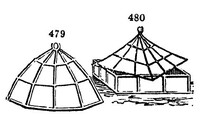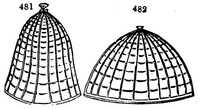1864. Hand-glasses are of various species. The leaden hand-glass is a small portable glazed case, formed by grooved strips of lead, and is either square or polygonal in the plan and roof. It is used for the protection of culinary and other plants, during the winter months; its first cost is less than that of any other hand-glass. The copper hand-glass (fig. 479.) is a very light and elegant variety of hand-glass, in which the bars are formed of copper, and the sides bevelled; the top or roof sometimes projecting over the latter, with glass eaves. The lead hand-glass is the cheapest, but this is by far the most elegant. The cast-iron hand-glass (fig. 480.) consists of two parts; the sides are either square or polygonal, and the top is of suitable shape. Each side is cast separate, with screws and nuts; the four sides are afterwards screwed together, and the top, which is always kept separable, is cast in one piece. When air is to be given to the plants enclosed, it is done by lifting up the top, and replacing it diagonally, by which means air is admitted in every direction; and one advantage of not being obliged to lift the bottom part is, that in severe weather, when it is frozen to the ground, air is admitted without danger of breaking the glass; and also that the leaves of large plants, as of cauliflower, are less liable to be injured in replacing it. A glass case may be composed from two or three of these hand-glasses, of any height, by placing two or three bottom frames one above the other. The relative prices, the size and shape being the same, are in the order of lead, copper, and cast iron. A variety of this kind of hand-glass is made with one of the panes to open, so as to form a kind of window. The wrought-iron hand-glass (figs. 481. and 482.) is composed of solid iron sash-bars, and may, therefore, be formed of any shape or height. It is particularly eligible for covering tender shrubs planted in the open air, as the tree pï¾µony, some half-hardy mimosas, &c.; and even pelargoniums and fuchsias in the south of England. These frames are sometimes used without glass, being merely covered with a mat.



